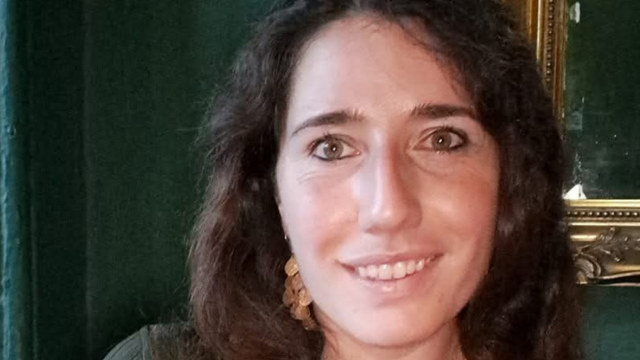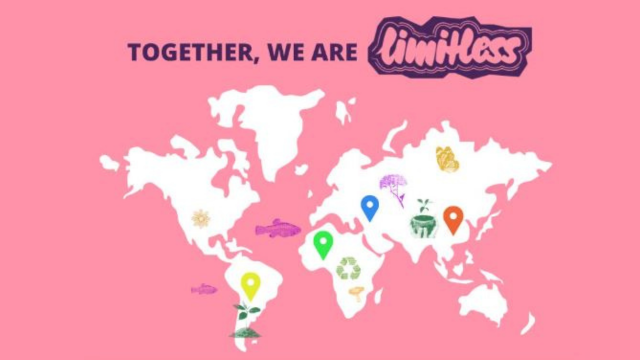-
QUALIFICATIONS
- For Linguists Worldwide
- For UK Public Services
- Preparation
- Policies & Regulation
-
MEMBERSHIP
- Join CIOL
- Professional Membership
- Affiliate Membership
- Chartered Linguist
- Already a member?
- Professional conduct
- Business & Corporate Partners
-
LANGUAGE ASSESSMENTS
- English
- All Other Languages
-
CPD & EVENTS
- Webinars & Events
- CIOL Conferences
- Networks
- CIOL Mentoring
-
NEWS & VOICES
- News & Voices
- CIOL eNews
- CIOL Awards
- The Linguist Magazine
- Jobs & Ads
-
RESOURCES
- For Translators & Interpreters
- For Universities & Students
- Standards & Norms
- CIOL & AI
- All Party Parliamentary Group
- In the UK
- UK Public Services
- Find-a-Linguist
Seeing a drop in translation work? Let’s talk solutions
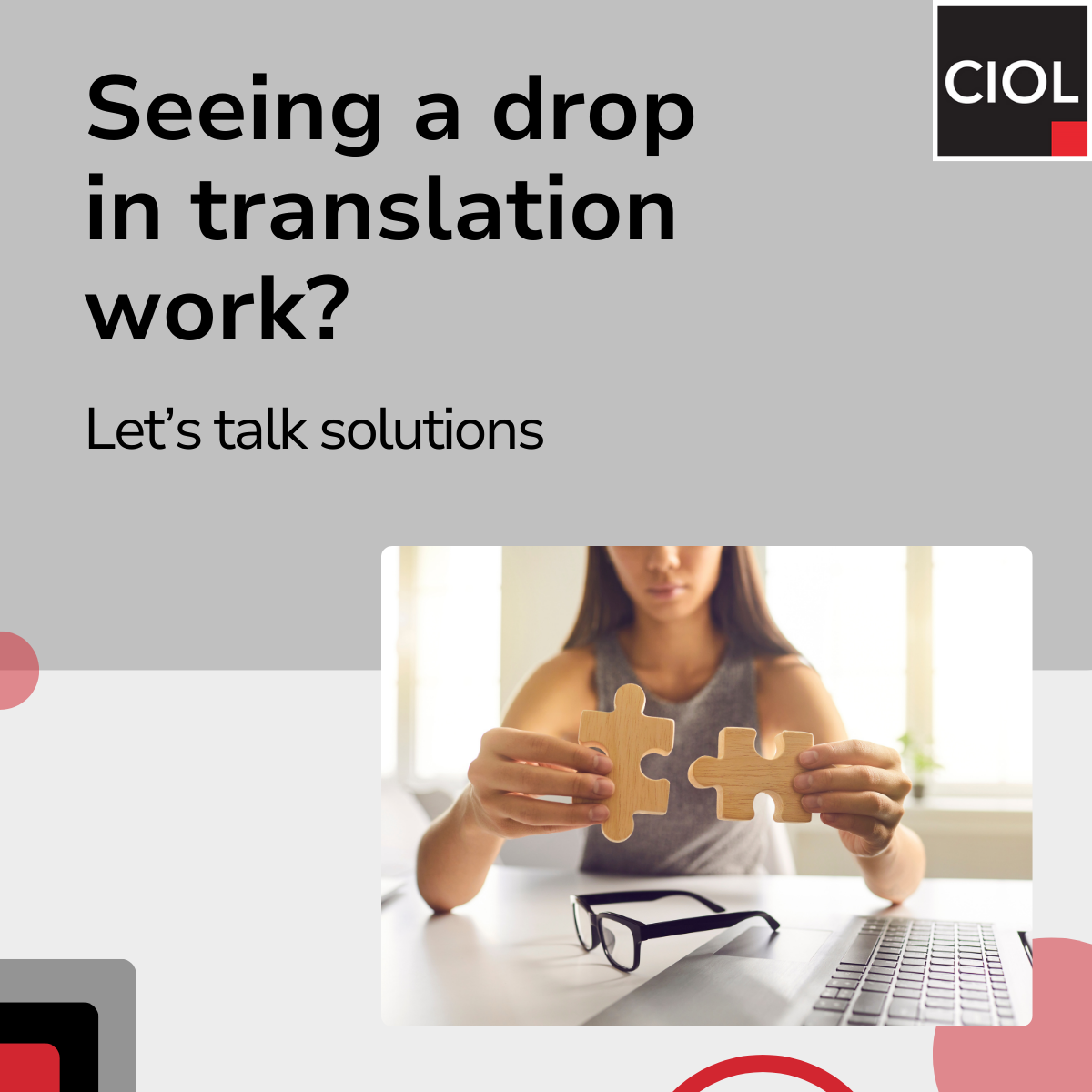
‘I started getting fewer enquiries in all languages, so not just in my own language pair of English–French, but also in the other languages that I was representing through my agency’ Karine Chevalier-Watts
It’s no secret that many freelance translators and translation agencies started seeing a drop in translation workload in 2024. However, some translators have managed to turn things to their advantage. In this article, we’ll look at what’s happened and the solutions freelancers are finding.
This is post one in a set of three follow-up posts to the CIOL roundtable Freelance linguists: navigating careers in a changing profession featuring Ilenia Goffredo, Karine Chevalier-Watts and Ibrahim Kadouni. It explores and expands on the panellists’ ideas and contributions to show you what’s changed in translation and what you can do to continue to succeed.
Watch the full roundtable video.
What’s gone wrong for some translators?
Karine Chevalier-Watts was running a small and successful translation agency until work suddenly slowed down. In addition to having fewer client enquiries, she noted:
‘I started getting more spontaneous applications from freelance linguists from around the world and from foreign language agencies. I was checking out their rates and I thought: "Wow, they're offering much cheaper rates than I can ever afford in the UK". I thought I could never compete with those people.’
In 2024, artificial intelligence (AI) emerged in a maelstrom of marketing hype. This led to two major shifts in client behaviour that caused a drop in translation work for many freelancers:
- Humans sometimes got cut out of the translation process with low-end clients believing that AI output was good enough.
- It became normalised to process significant translation volumes via generative AI translation with human post-editing. A single human translator is now able to turn around far higher volumes than ever before, while achieving quality levels that are acceptable for the client.
This seemed to happen almost overnight.
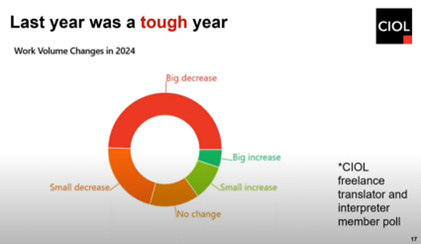
The entry of AI marked a before-and-after point in the lives of translators, interpreters and language educators. And in the lives of every other person and business with access to it.
But is it only AI that’s impacting language services?
‘I tend to interpret these changes in line with the entire global market landscape because, at the end of the day, just like any other industry and any other field, we’re sensitive to this wider landscape’
Ibrahim Kadouni.
Is it only AI that’s impacting language services, though? Short answer, no. As Dom Hebblethwaite showed in his fascinating introduction to the roundtable, geopolitics are also playing a role.
Brexit had a regrettable impact on the value of languages in the UK and trade with the EEA. It led to an upturn in Certified Translation work but a general downturn everywhere else.
More recently, billion-dollar USAID budget cuts have led to massive reductions in translation, interpreting and language education in support of international development.
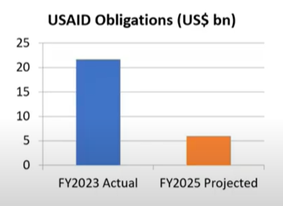
With all this going on, it’s no wonder that many translators have been struggling to generate enough income on translation alone.
What’s the outlook for language service providers?
According to the Slator 2025 Language Service Provider Index: ‘we estimate organic growth across the ca. 300 companies featured to be flat.’ In short, some LSPs are growing and some are shrinking, while others are being merged and acquired.
The Slator 2025 Language Industry Market Report claims the market is worth USD 31.7 billion. So, big money still.
What’s perhaps more telling for a freelance translator wondering about their place in language services, are words that Slator uses like 'Language Technology Platforms' (LTPs) and 'Language Solutions Integrators' (LSIs), which ‘enable language transformation through fully automated, expert-in-the-loop and human-led delivery models’. And don’t miss the concept of translation as a feature (TaaF), where any old tech platform integrates 'automated translation' so users are promised they can translate content at the touch of a button.
‘I mean, there is that certain challenge: the commoditisation of translation itself, that commoditisation of the value we always brought, especially by large tech platforms with the growing prevalence of neural machine translation. It's increasingly becoming a feature. This has led to a dangerous perception that human expertise is easily interchangeable with machine output or with machine work’
Ibrahim Kadouni.
Do all translators have less work now?
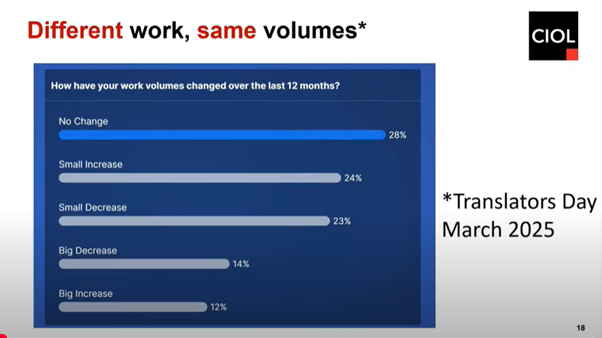
Why? Minority languages have been less impacted by AI than majority ones. But that alone isn’t enough to explain why most translators are staying afloat, with a sizeable number getting more work.
What’s the solution to less translation work?
'In a nutshell, the opportunities are there, but you’ll need more than linguistic flair to seize them. If you want to stay in the game, you have to play it smart. Specialise wisely, build relationships and, above all, offer clients not just words, but solutions in context’
Ibrahim Kadouni.
Translators have always spoken about the different 'hats' they wear: writer, editor, proofreader, business owner. Nevertheless, it seems the time has now come to add a few more hats to your professional wardrobe. So, what’s hot this season?
Working with AI
‘It’s about how we leverage it … It’s pushing us to accelerate and evolve quite fast … We should really stop feeling that we have to compete with AI. The attitude is the biggest challenge: changing our mindset and trying to be as proactive as possible in finding ways of moving forward’
Ilenia Goffredo.
Have you ever encountered someone who challenged you in a way that made you improve? A Federer to your Nadal, a Blur to your Oasis, a Pepsi to your Coca-Cola?
Mindset is everything when you’re dealing with a force like AI (as I will explore in a later post in this series). Try thinking about it as a motivator, a bright-eyed intern, a tool, a superpower.
Human vs AI is about marketing … and what the client wants
‘We can sit here and talk about the things that we're great at compared to AI or what AI can do a lot better compared to us, but, ultimately, it’s about how we market ourselves’
Ilenia Goffredo.
When it comes to making money, you have to give the client what they want. You can try to guide them, but sometimes they won’t listen and it’s best to just work with them.
If you’ve seen a drop in translation work, it’s because clients don’t want that type of work anymore. It hurts, but that’s business. However, these clients still have global operations. They still want international success. And they can’t do it alone with just their dysfunctional AI interns for guidance. So, what do they want, or need, from translators? And how are you going to market yourself to show them you can provide it?
What do language service clients want in 2025?
‘Clients are looking not just for language experts but for what I call language consultants, language artisans as I put it on my LinkedIn headline, professionals who can bridge language strategy and technology.’
Ibrahim Kadouni.
Translators have plenty of skills and knowledge: linguistic, cultural, book learned, craft based, business related, specialism generated. The translators who are flourishing today understand how to use all that in a way that aligns with current client demands.
‘At the end of the day, it’s about how we position ourselves, how we adapt to different realities, how we present our relevance. I had an interpreting gig for an entrepreneur from the UK, an English speaker who has been doing business in the Arab world. He was struggling in that all his meetings were with English speakers from the Arab world. But he felt that his nuances weren’t travelling across language, and this impeded some business opportunities.
So, from that small meeting, which went for one hour, I realised that their website had many issues which had to do with copywriting. And this was where I brought my relevance and my value.’
Ibrahim Kadouni.
Client retention is an opportunity
‘To win new business, client retention might be easier compared to actually winning new clients in this kind of landscape’
Ilenia Goffredo.
All the roundtable panellists emphasised the importance of making sure you understand your client’s circumstances and needs. Ilenia Goffredo underlined how your existing clients may need other services beyond translation.
It’s therefore more important than ever to communicate with them and find out what these needs may be. By understanding your clients and potential clients, you’ll have a much better chance of coming up with a suitable service offering.
Freelance vs in-house language services
Another solution is taking up a part- or full-time in-house position, possibly while maintaining your freelance services on the side. Once again, reaching out to existing contacts is likely to yield faster results than trying to make new ones.
Clients won’t know you want to go in-house unless you tell them. During the roundtable, Karine Chevalier-Watts shared the story of how she moved from freelance translator and translation agency owner to the in-house role of bilingual paralegal and certified translator for an existing client:
‘They were happy with the quality of our services and then I found out one day they had an offering in their team for a bilingual paralegal, and I applied, as simple as that. Working full-time for this law firm has enhanced my knowledge of being a freelance legal translator. I found out that my clients are very happy to hear that on top of being a sworn legal translator, I'm also working in the law industry.
This has actually helped me to increase my prices because I've now got this added recognition that I'm not just a translator; I'm being seen as a legal expert, too. So, I would say to keep an open mind. If you see an opportunity, if you have a particular client that you've had a very good relationship with […], it's worth inquiring if they've got any openings in their company where your services might be useful.’
Karine Chevalier-Watts
5 Top tips on how translators can thrive
Several other great ideas came out of the roundtable. What would happen if you acted on all these suggestions from the panellists?
1. Offer translation as a premium service
Since AI is driving costs down, maybe it’s time to forget negotiating. If you don’t want to post-edit, what about offering human translation as a premium service? Go after the top projects that still require humans and forget about anything that doesn’t inspire you.
2. Upskill
By staying adaptable, offering in-demand skills and knowing how to work with evolving tools and workflows, you’ll be much better placed to meet your clients’ new demands. In fact, you may even be able to anticipate them, and that’ll give you a real competitive advantage.
Here is a list of areas where translators are upskilling:
- Post-editing AI and machine translation output
- Adding new languages
- Subtitling, dubbing and voiceover
- Interpreting
- Project management
- Copywriting and SEO
- User experience (UX)
- Developmental editing, copyediting and proofreading
- Localisation consultancy
- Language teaching and course writing
3. Embrace hybrid roles
By having a job where you cover two roles, such as Karine’s example of becoming an in-house paralegal in addition to being a certified translator, you get a much better picture of your relevance and value. You better understand clients and the market, and you get to keep your curious translator’s mind occupied. With broader experience, it’ll be easier for you to anticipate change and adapt.
4. Specialise wisely
For early-career translators, specialisation will likely give you a competitive edge. It’s also another way to embrace hybridity, by being able to turn your hand to more than one role within the niche. So, when you choose your domain, make sure you stay flexible within it by developing a range of skills. Don’t box yourself in.
5. Network
Invest time and, if necessary, money in building a strong network. This includes clients and potential clients, colleagues and peers. Good places to network include through professional bodies like CIOL or conferences and other CPD activities. People still work with people. If clients know you, they’re much more likely to call you for work than if you’re just a name on a CV.
The future is bright for linguists
So, as you can see, it isn’t all doom and gloom. There’s a bright future ahead full of very interesting options for translators who can think about change positively and turn it to their advantage.
However, no one is pretending that this is easy. Many of us love being translators and it forms part of our identity. If you’re struggling with this, you’re not alone. In article two in this series, we’ll explore professional identity and what a translator’s evolution might look like. Watch this space...

Gwenydd Jones is the founder of The Translator's Studio. She has broad experience as a content strategist in the worlds of localisation, writing, education and software.
Views expressed on CIOL Voices are those of the writer and may not represent those of the wider membership or CIOL.
Filter by category
More
The Chartered Institute of Linguists (CIOL), Incorporated by Royal Charter, Registered in England and Wales Number RC 000808 and the IoL Educational Trust (IoLET), trading as CIOL Qualifications, Company limited by Guarantee, Registered in England and Wales Number 04297497 and Registered Charity Number 1090263. CIOL is a not-for-profit organisation.


